

Hoover Dam
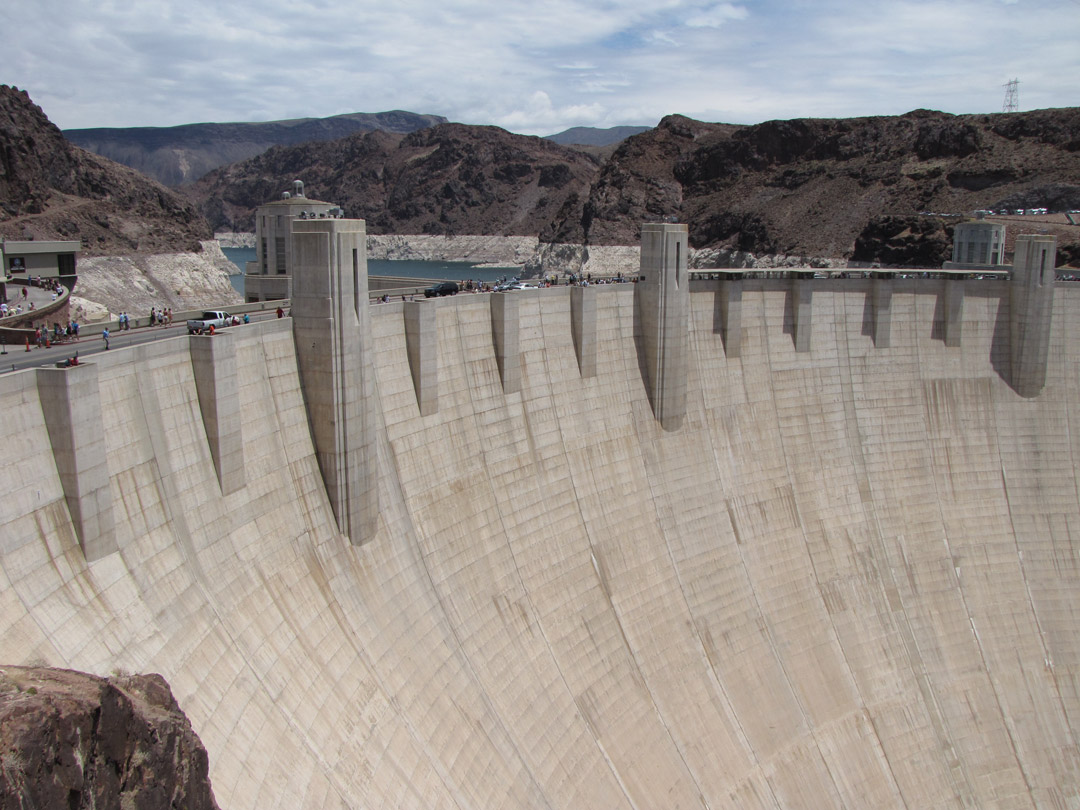
Hoover Dam
Hoover Dam, originally known as Boulder Dam, is a concrete arch-gravity dam in the Black Canyon of the Colorado River, on the border between the U.S. states of Arizona and Nevada. When completed in 1936, it was both the world's largest electric-power generating station and the world's largest concrete structure. It was surpassed in both these respects by the Grand Coulee Dam in 1945. It is currently the world's 35th-largest hydroelectric generating station.

This dam, located 30 miles (48 km) southeast of Las Vegas, Nevada, is named
after Herbert Hoover, who played an instrumental role in its construction, first
as the Secretary of Commerce and then later as the President of the United
States. Construction began in 1931 and was completed in 1936, more than two
years ahead of schedule. The dam and the power plant are operated by the Bureau
of Reclamation of the U.S. Department of the Interior. Listed on the National
Register of Historic Places in 1981, Hoover Dam was designated a National
Historic Landmark in 1985.
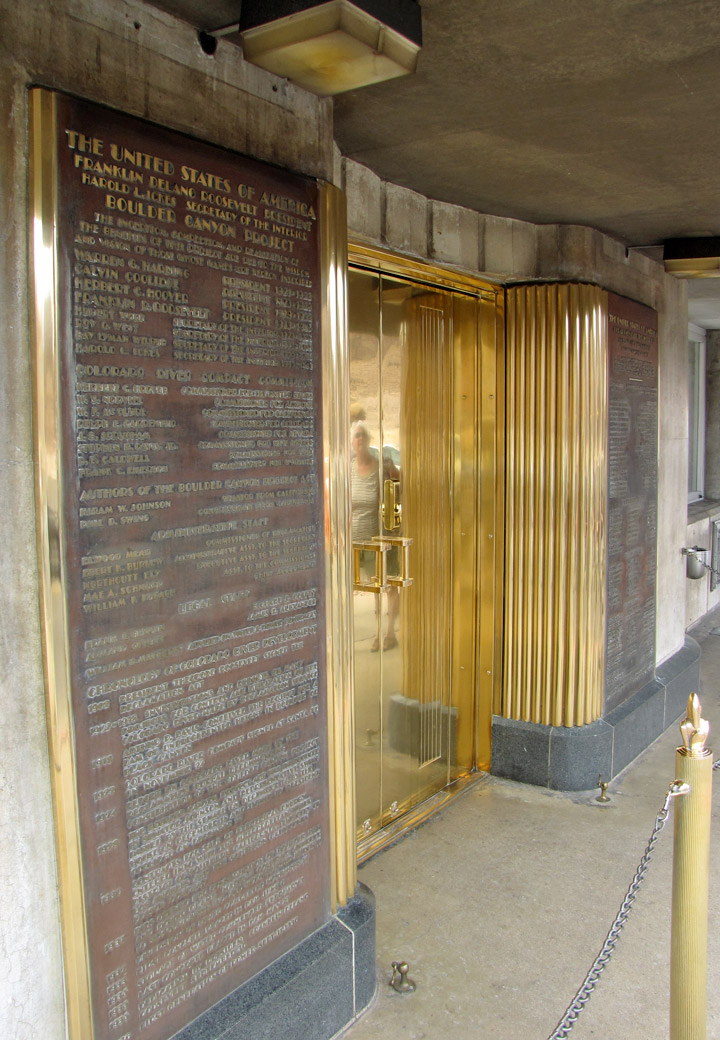
Lake Mead is the reservoir created behind the dam, named after Elwood Mead, who
oversaw the construction of the dam.
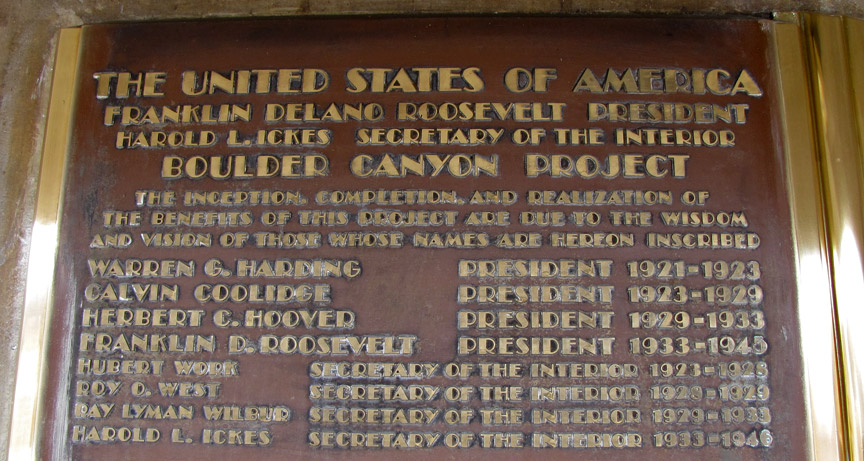
A commission was formed in 1922 with a representative from each of the Basin
states and one from the Federal Government. The federal representative was
Herbert Hoover, then Secretary of Commerce under President Warren Harding. In
January 1922, Hoover met with the state governors of Arizona, California,
Colorado, Nevada, New Mexico, Utah, and Wyoming to work out an equitable
arrangement for apportioning the waters of the Colorado River for their states'
use. The resulting Colorado River Compact, signed on November 24, 1922, split
the river basin into upper and lower halves with the states within each region
deciding how the water would be divided. This agreement, known as the Hoover
Compromise, paved the way for the Boulder Dam Project. This huge dam was built
to provide irrigation water flow, for flood control, and for hydroelectric-power
generation.
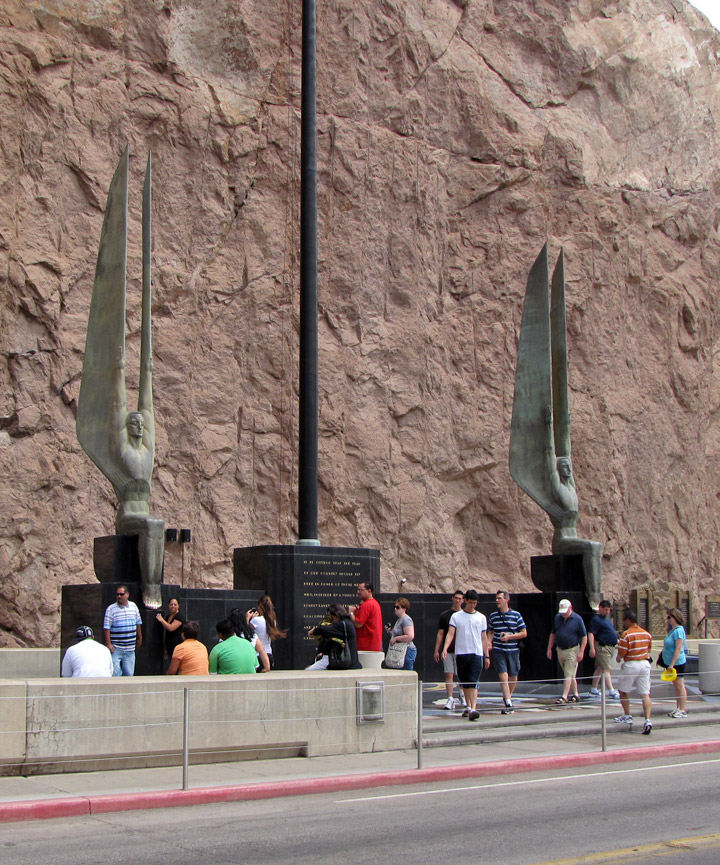
More Photos of the Museum and Power Plant Tour
The first attempt to gain Congressional approval for construction of Boulder Dam came in 1922 with the introduction of two bills in the House of Representatives and the Senate. The bills were introduced by Congressman Phil D. Swing and Senator Hiram W. Johnson and were known as the Swing-Johnson bills. The bills failed to come up for a vote and were subsequently reintroduced several times. In December 1928, both the House and the Senate finally approved the bill and sent it to the President for approval. On December 21, 1928, President Calvin Coolidge signed the bill approving the Boulder Canyon Project. The initial appropriation for construction was made in July 1930, by which time Herbert Hoover had become President.
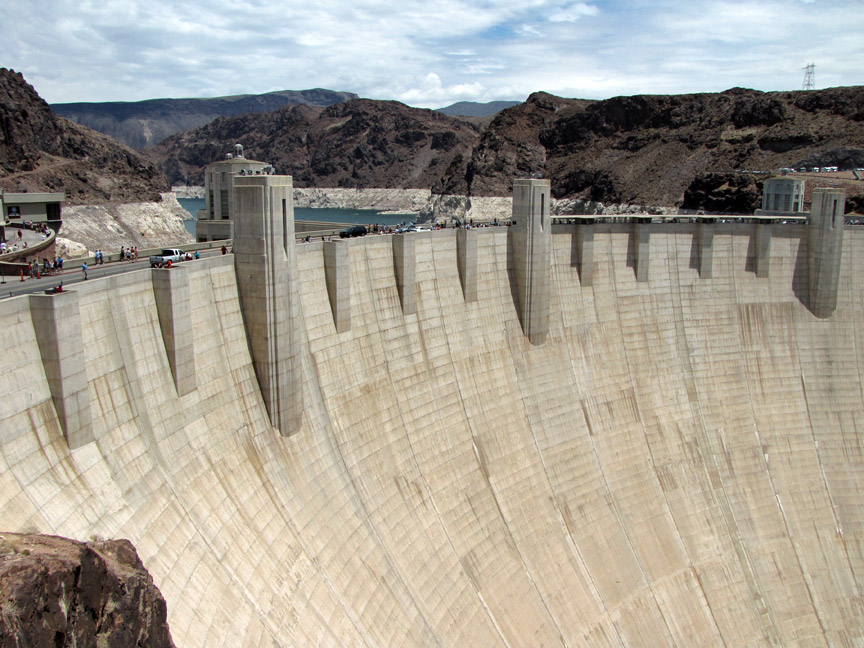
Early plans called for the dam to be built in Boulder Canyon, so the project was
known as the Boulder Canyon Project. The dam site was eventually moved
downstream eight miles (13 km) to Black Canyon, but the project name remained
the same.
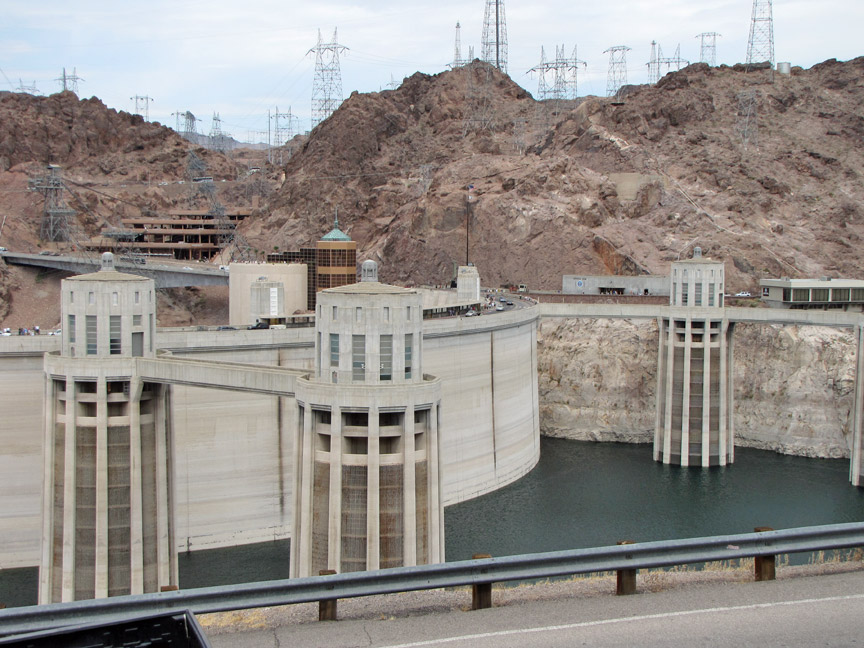
The contract to build the Boulder Dam was awarded to Six Companies, Inc. on
March 11, 1931, a joint venture of Morrison-Knudsen Company of Boise, Idaho;
Utah Construction Company of Ogden, Utah; Pacific Bridge Company of Portland,
Oregon; Henry J. Kaiser & W. A. Bechtel Company of Oakland, California;
MacDonald & Kahn Ltd. of Los Angeles; and the J.F. Shea Company of Portland,
Oregon. The chief executive of Six Companies, Frank Crowe, had previously
invented many of the techniques used to build the dam.
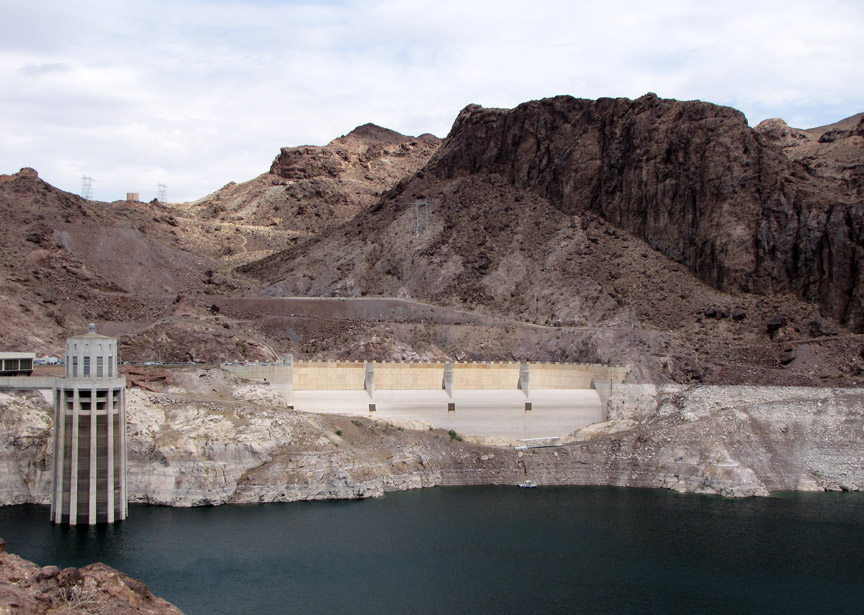
Nevada side overflow spillway
During the concrete-pouring and curing portion of construction, it was necessary to circulate refrigerated water through tubes in the concrete. This was to remove the heat generated by the chemical reactions that solidify the concrete, since the setting and curing of the concrete was calculated to take about 125 years if cooling was not done. Six Companies, Inc., did much of this work, but it discovered that such a large refrigeration project was beyond its expertise. Hence, the Union Carbide Corporation was contracted to assist with the refrigeration needs.
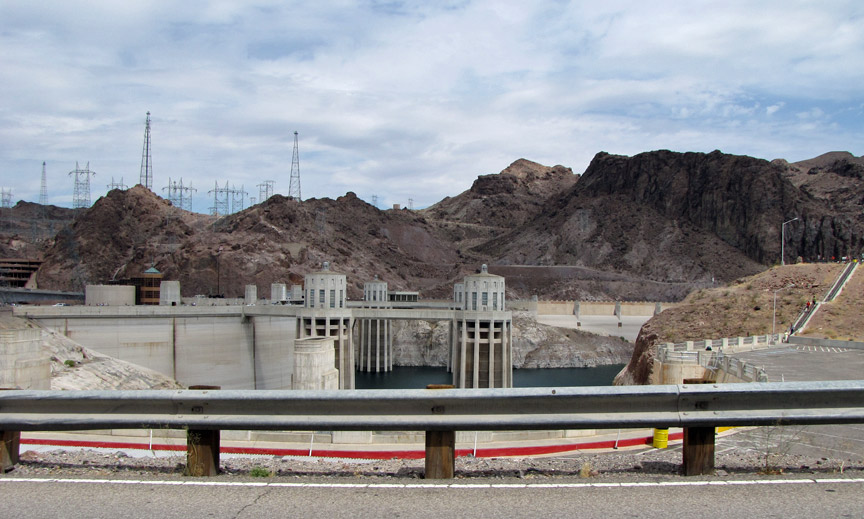
Six Companies, Inc. was contracted to build a new town called Boulder City for
workers, but the construction schedule for the dam was accelerated in order to
create more jobs in response to the onset of the Great Depression, and the town
was not ready when the first dam workers arrived at the site in early 1931.
During the first summer of construction, workers and their families were housed
in temporary camps like Ragtown while work on the town progressed. Discontent
with Ragtown and dangerous working conditions at the dam site led to a strike on
August 8, 1931. Six Companies responded by sending in strike-breakers with guns
and clubs, and the strike was soon quelled. But the discontent prompted the
authorities to speed up the construction of Boulder City, and by the spring of
1932 Ragtown had been deserted. Gambling, drinking alcohol, and prostitution
were not permitted in Boulder City during the period of construction. To this
day Boulder City is one of only two locations in Nevada not to allow gambling,
and the sale of alcohol was illegal until 1969.
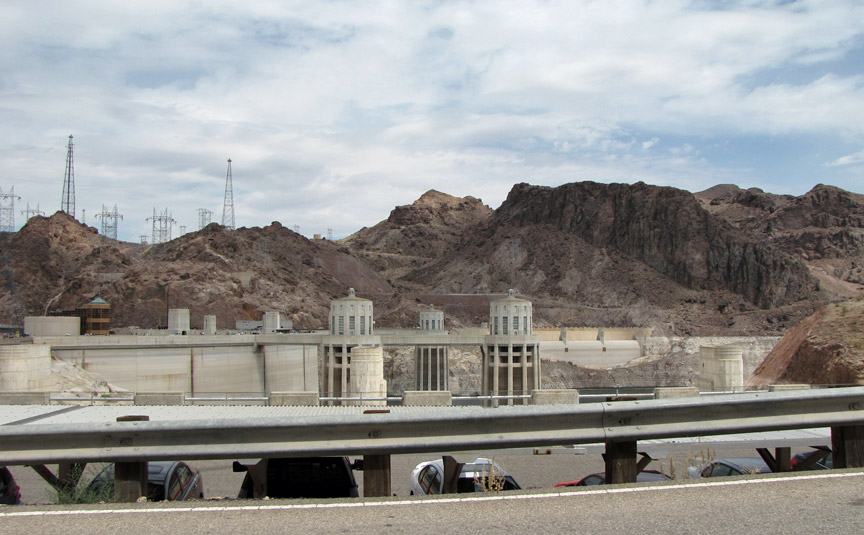
While working in the tunnels, many workers suffered from the carbon monoxide
generated by the machinery there. The contractors claimed that the sickness was
pneumonia and was not their responsibility. Some of the workers sickened and
died because of the so-called "pneumonia". Most are uncounted on the official
death list. In a court case, one of the claimants (Ed Kraus) said that the
poisoning had resulted in his impotence. This was disproved after a prostitute
in the pay of the contractors gave evidence. The jury failed to reach a verdict
as a result, and the claim was lost.

To protect the construction site from flooding, two cofferdams were constructed.
Construction of the upper cofferdam began in September 1932, even though the
river had not yet been diverted. A temporary horseshoe-shaped dike protected the
cofferdam on the Nevada side of the river. After the Arizona tunnels were
completed, and the river diverted, the work was completed much faster. Once the
cofferdams were in place and the construction site dewatered, excavation for the
dam foundation began. For the dam to rest on solid rock, it was necessary to
remove all the riverbed's accumulated erosion soils and other loose materials
until sound bedrock was reached. Work on the foundation excavations was
completed in June 1933. During excavations for the foundation, approximately
1,500,000 yd³ (1,150,000 m³) of material was removed. Since the dam would be a
gravity-arch type, the side-walls of the canyon would also bear the force of the
impounded lake. Therefore the side-walls were excavated too, to reach virgin
(un-weathered) rock which had not experienced the weathering of centuries of
water seepage, wintertime freeze cracking, and the heating/cooling cycles of the
Arizona/Nevada desert.
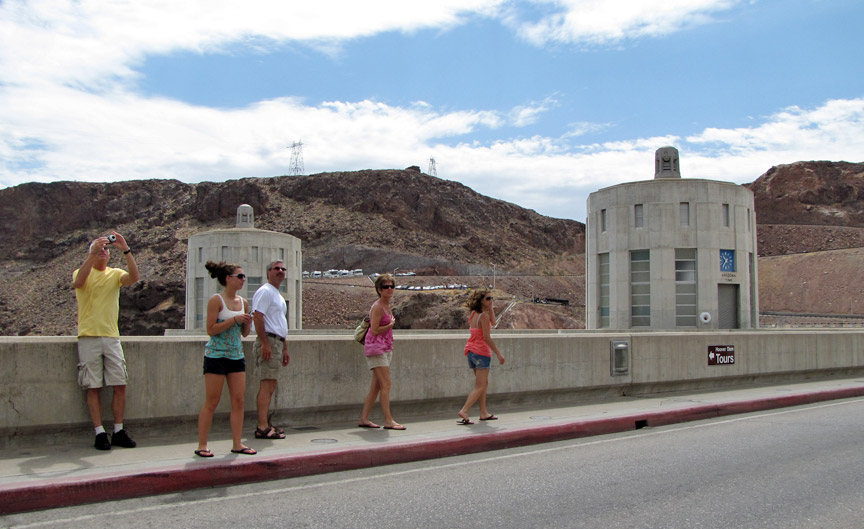
walking across the dam
To divert the river's flow around the construction site, four diversion tunnels were driven through the canyon walls, two on the Nevada side and two on the Arizona side. These tunnels were 56 feet (17 m) in diameter. Their combined length was nearly 16,000 feet (4877 meters, more than three miles). Tunneling began at the lower portals of the Nevada tunnels in May 1931. Shortly afterwards, work began on two similar tunnels in the Arizona canyon wall. In March 1932, work began on lining the tunnels with concrete. First the base, or invert, was poured. Gantry cranes, running on rails through the entire length of each tunnel were used to place the concrete. The sidewalls were poured next. Movable sections of steel forms were used for the sidewalls. Finally, using pneumatic guns, the overheads were filled in. The concrete lining is three feet (91.5 centimeters) thick, reducing the finished tunnel diameter to 50 feet (15.25 m).
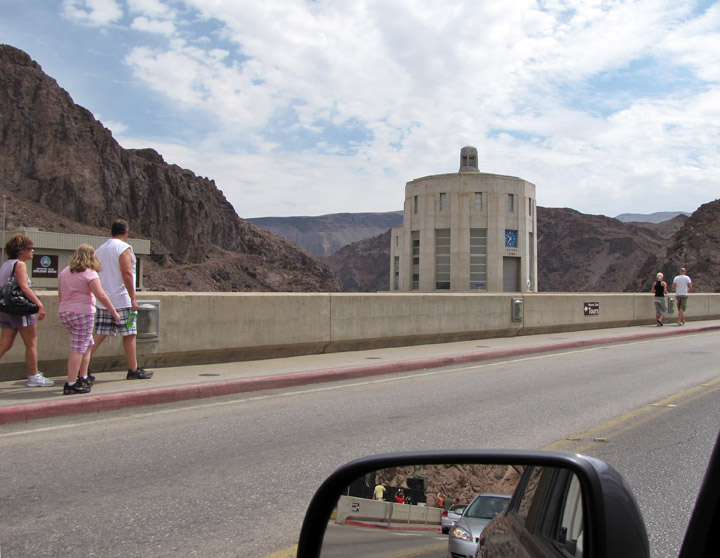
in the car driving across the dam
Following the completion of the dam, the entrances to the two outer diversion tunnels were sealed at the opening and half way through the tunnels with large concrete plugs. The downstream halves of the tunnels following the inner plugs are now the main bodies of the spillway tunnels. The spillways can be seen directly above the outer diversion tunnels. They drop sharply from their entrance point and merge directly into the old diversion tunnels.
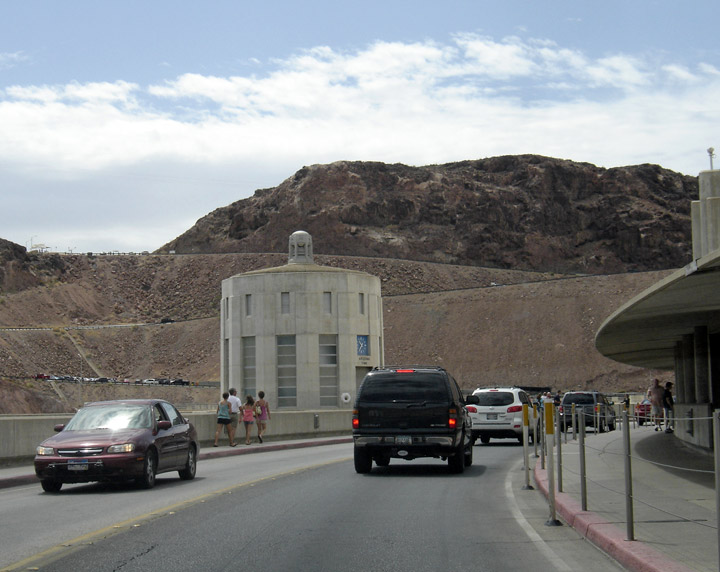
The two inner diversion tunnels have two concrete plugs in them. One is roughly
half way along their length, and the other is around 75% of the way along their
length. The section sandwiched between two concrete plugs is used as part of the
tunnel which water travels along, to journey from the outermost intake towers
and the generators. The two innermost intake towers have separate tunnels.
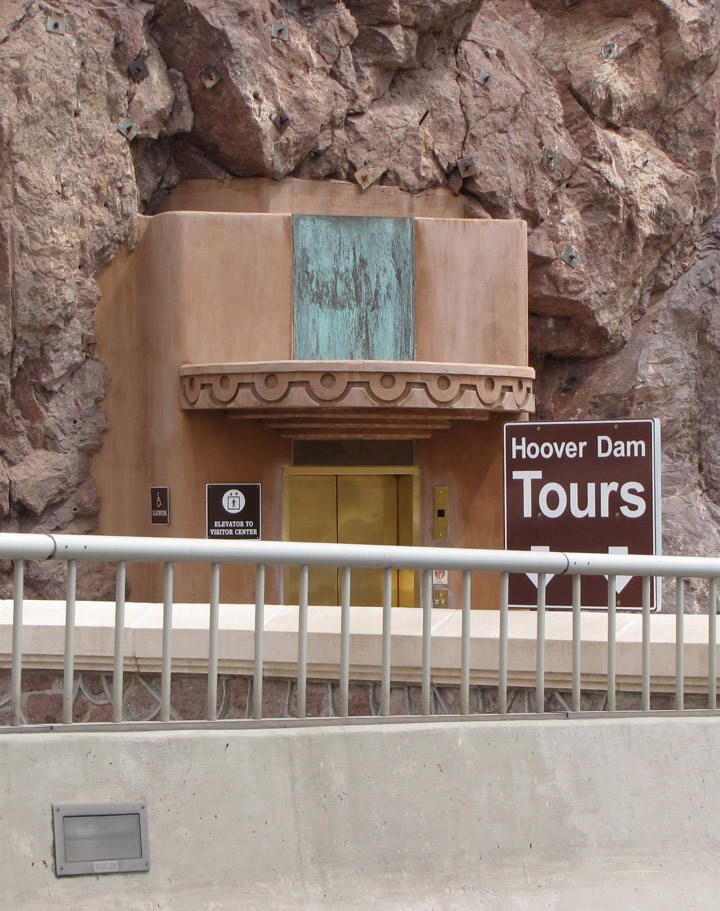
The large spillway tunnels have only been used three times in the history of the
dam. The first one was during the second half of 1941 for testing. The second
one was for about six weeks during the summer of 1983, when record precipitation
and snow-melt in the Colorado River basin drained into Lake Mead, and the third
one in 1999, again with heavy precipitation that filled Lake Mead.

The two vertical foundations for each of the arch walls (the Nevada side and
Arizona side) had to be founded on sound virgin rock; free of cracks and the
weathering that the surface rock of the canyon walls had from thousands of years
of weathering and exposure.
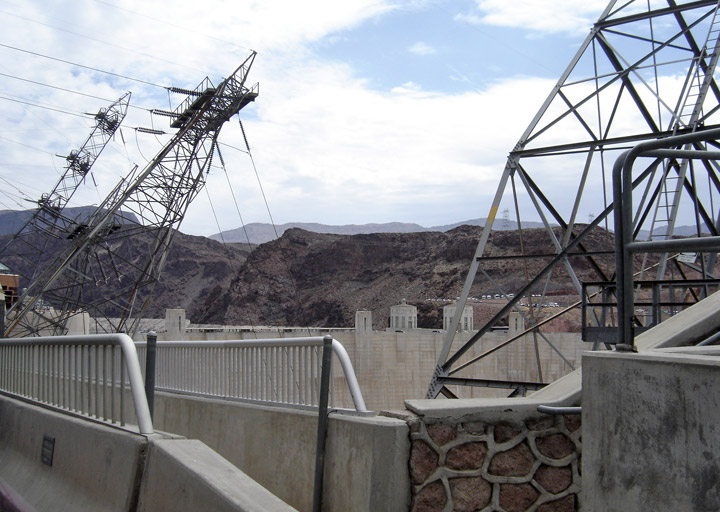
The men who removed this rock were called high-scalers. While suspended from the
top of the canyon with ropes high-scalers climbed down the canyon walls and
removed the loose rock with jackhammers and dynamite.
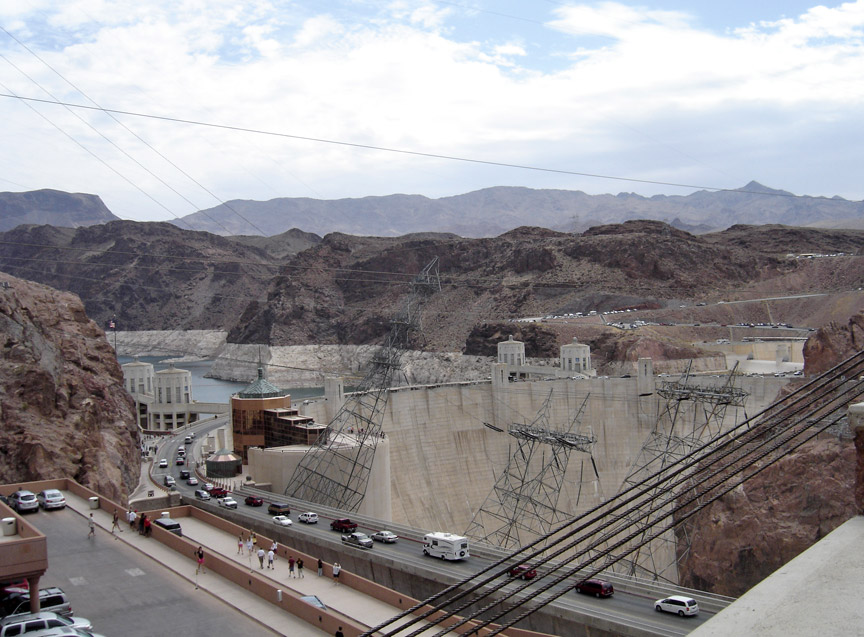
The first concrete was placed into the dam on June 6, 1933. Since no structure
of the magnitude of the Hoover Dam had been constructed, many of the procedures
used in construction of the dam were untried. Since concrete heats up and
contracts as it cures, uneven cooling and contraction of the concrete posed a
serious problem. The Bureau of Reclamation engineers calculated that if the dam
were built in a single continuous pour, the concrete would have taken 125 years
to cool to ambient temperature. The resulting stresses would have caused the dam
to crack and crumble. To solve this problem the dam was built in a series of
interlocking trapezoidal columns. Each pour was no more than six inches (152 mm)
deep. Because of this depth it is extremely unlikely that construction workers
were accidentally buried alive in the concrete, contrary to popular folklore (cf
"Highwayman", by Jimmy Webb). To further cool the concrete each form contained
cooling coils of 1 inch (25 mm) thin-walled steel pipe. River water was
circulated through these pipes to help dissipate the heat from the curing
concrete. After this, chilled water from a refrigeration plant on the lower
cofferdam was circulated through the coils to further cool the concrete. After
each layer had sufficiently cooled, the cooling coils were cut off and pressure
grouted by pneumatic grout guns. The concrete is still curing and gaining in
strength as time goes on.
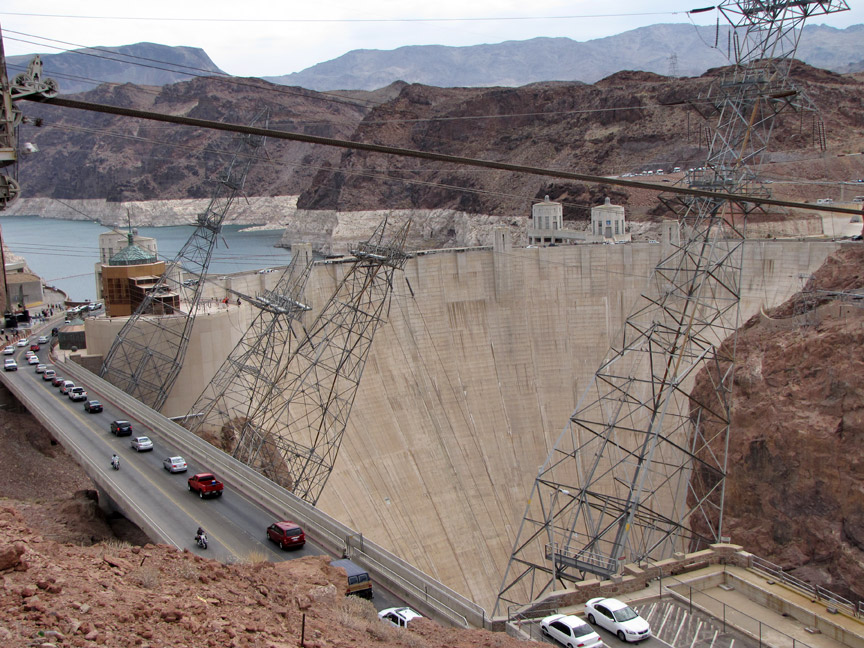
There is enough concrete in the dam to pave a two-lane highway from San
Francisco to New York.
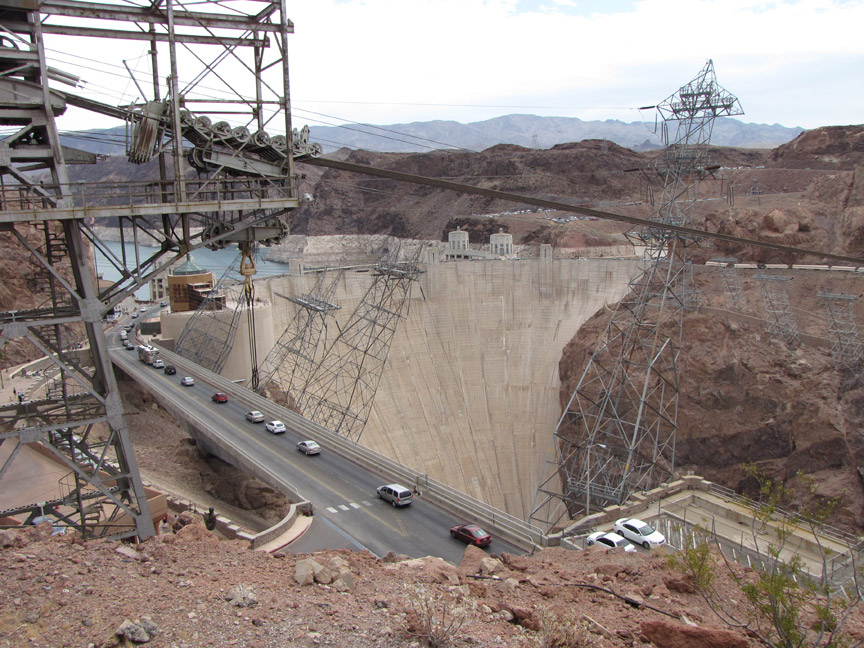
There were 112 deaths associated with the construction of the dam. There are
different accounts as to how many people died while working on the dam and who
was the first and last to die. A popular story holds that the first person to
die in the construction of Hoover Dam was J. G. Tierney, a surveyor who drowned
while looking for an ideal spot for the dam. Coincidentally, his son, Patrick W.
Tierney, was the last man to die working on the dam, 13 years to the day later.
Ninety-six of the deaths occurred during construction at the site. However,
another surveyor died prior to construction, while surveying a potential
location for the dam, and these statistics do not include other incidental and
coincidental (heat stroke, heart failure, etc) deaths during construction.
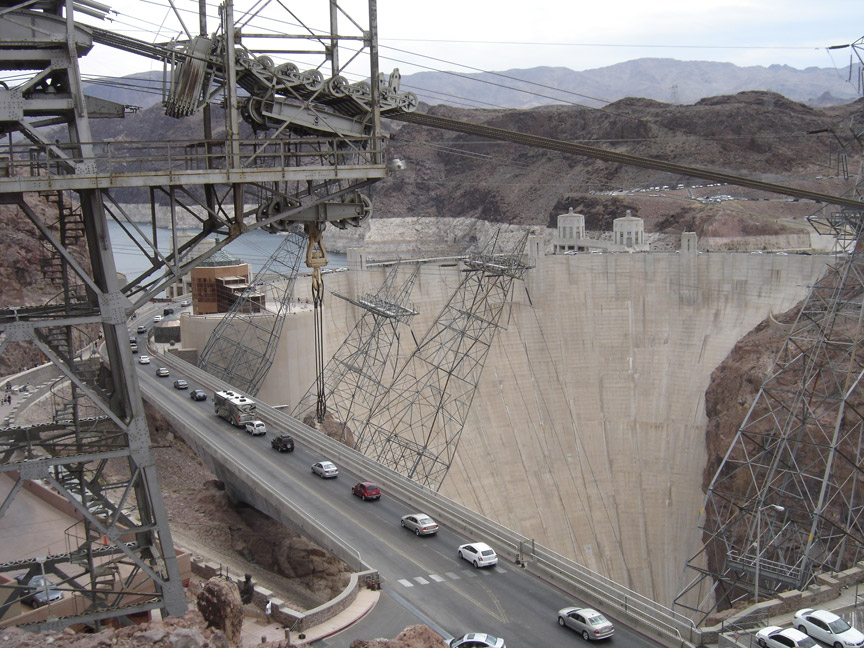
Hoover Dam and its associated changes in water use had devastating impact on the
Colorado River Delta at the mouth of the Colorado River. The construction of the
dam has been pointed to as the beginning of an era of decline of this estuarine
ecosystem. For six years in the late 1930s, after the construction of the
dam and while Lake Mead filled, virtually no flow of water reached the mouth of
the river. The delta's estuary, which once had a freshwater-saltwater mixing
zone stretching 65 kilometres (40 mi) south of the river's mouth, was turned
into an inverse estuary where the level of salinity was actually higher closer
to the river's mouth.
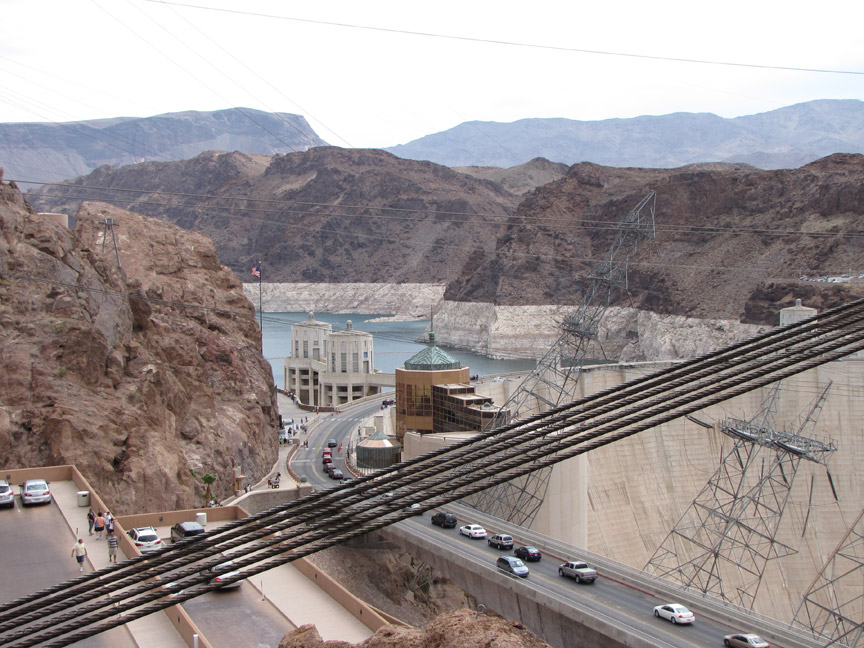
The Colorado River had experienced natural flooding before the construction of
the Hoover Dam. The dam eliminated the natural flooding, which imperiled many
species adapted to the flooding, including both plants and animals.
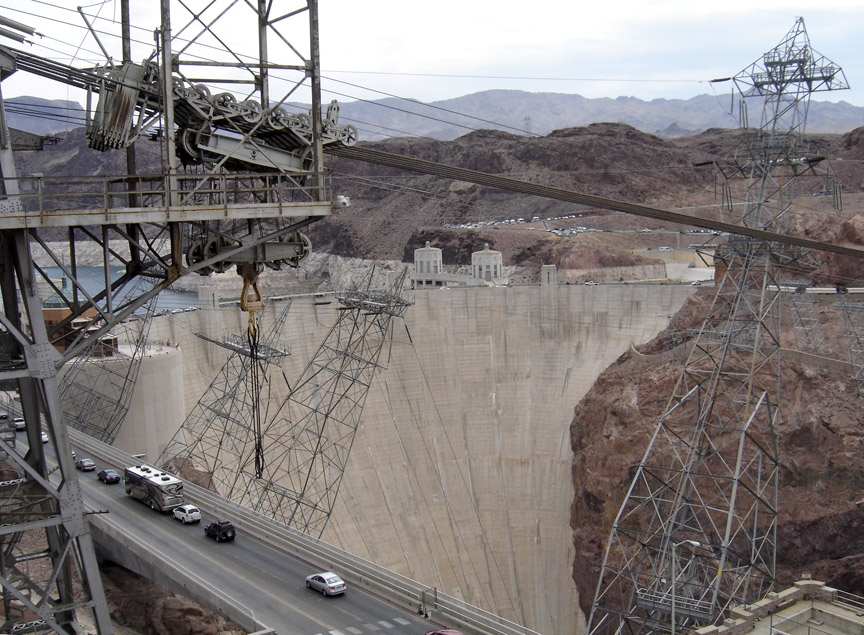
The construction of the dam decimated the populations of native fish in the
river downstream from the dam. Four species of fish native to the Colorado
River, the Bonytail chub, Colorado pikeminnow, Humpback chub, and Razorback
sucker, are currently listed as endangered by the U.S. federal government.
Hoover Dam on March 2009, the water level has decreased drastically.
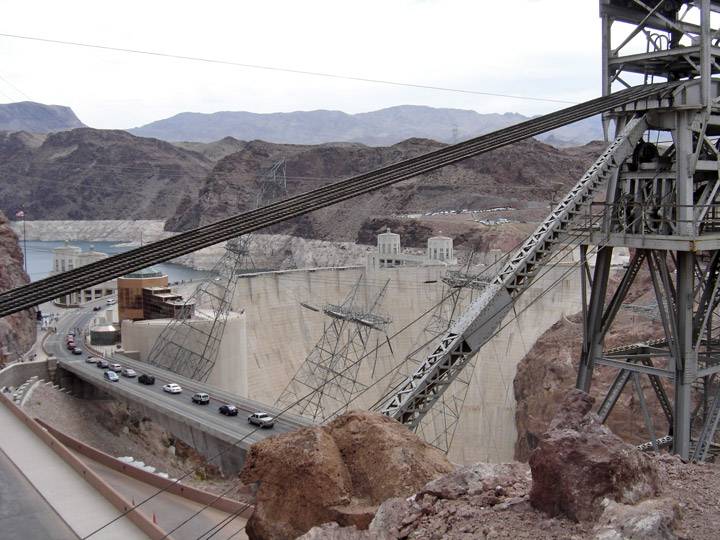
Following an uprating project from 1986 to 1993, the total gross power rating
for the plant, including two 2.4 megawatt electric generators that power the
plant's operations, is about 2080 megawatts.
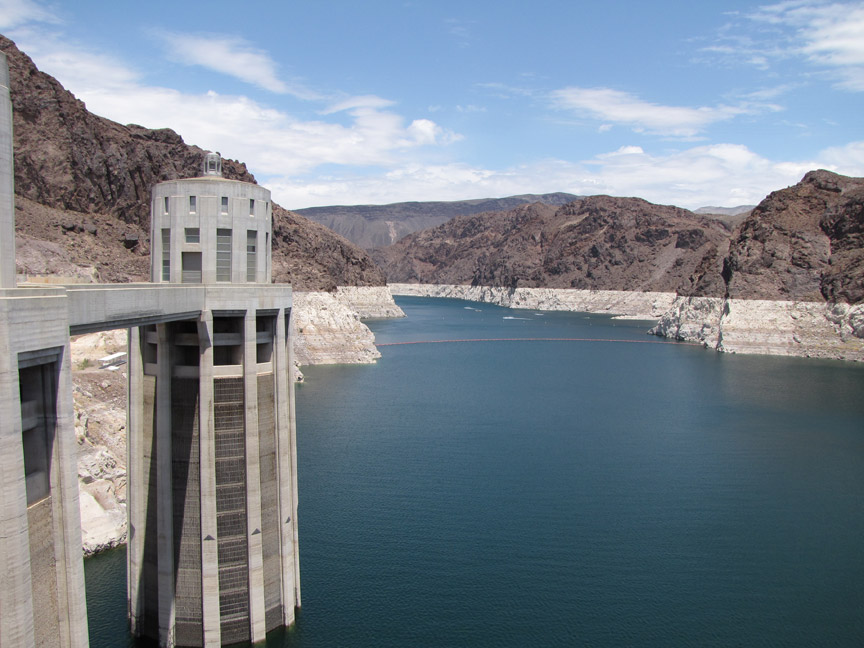
Excavation for the powerhouse was carried out simultaneously with the excavation
for the dam foundation and abutments. Excavation for the U-shaped structure
located at the downstream toe of the dam was completed in late 1933 with the
first concrete placed in November 1933.
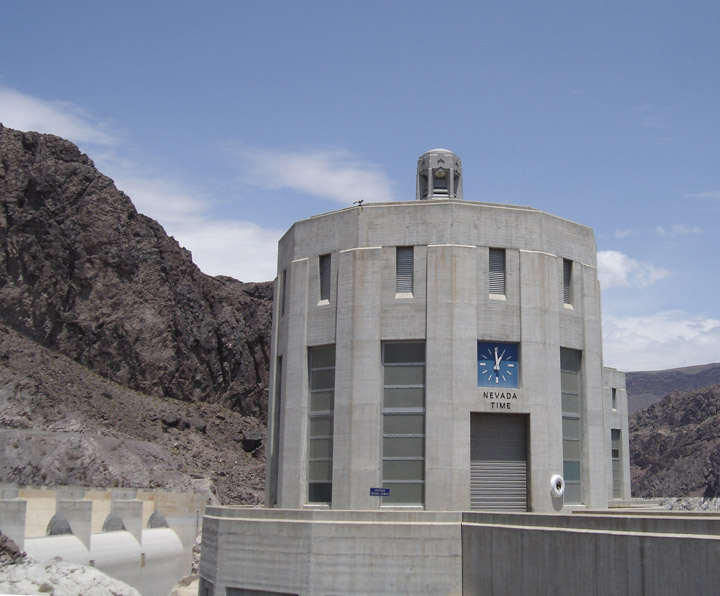
Generators at the Dam's Hoover Powerplant began transmission of electricity from
the Colorado River to Los Angeles, California 266 miles (428 km) away on October
26, 1936. Additional generating units were added through 1961. Original plans
called for 16 large generators, 8 on each side of the river (see architectural
illustrations) but two smaller generators were installed instead of one of the
large ones on the Arizona side, for a total of 17. The smaller generators were
used to serve smaller municipalities at a time when the output of each generator
was dedicated to a municipality, before the dam's total power output was placed
on the grid and made arbitrarily distributable.
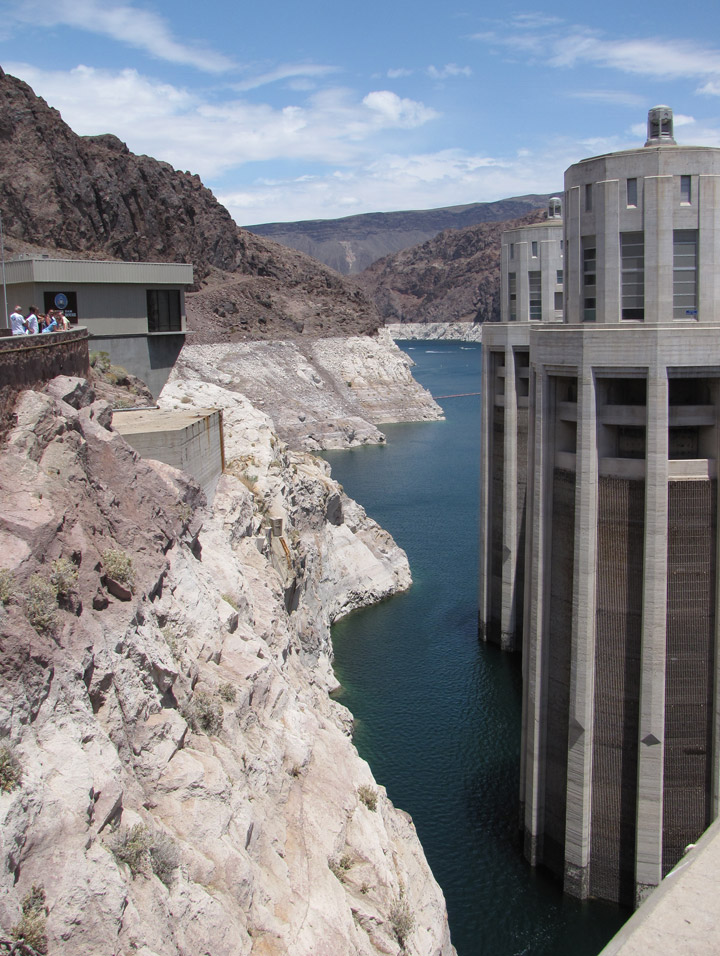
Water flowing from Lake Mead through the gradually-narrowing penstocks to the
powerhouse reaches a speed of about 85 miles per hour (140 km/h) by the time it
reaches the turbines. The entire flow of the Colorado River passes through the
turbines (except for seepage around the edges of the dam through the semi-porous
volcanic rock it rests against). The spillways are rarely used.

More Photos of the new highway bridge
Hydroelectric power plants have the ability to vary the amount of power generated, depending on the demand. Steam turbine power plants are not as easily throttled because of the amount of thermodynamic inertia contained in their systems.
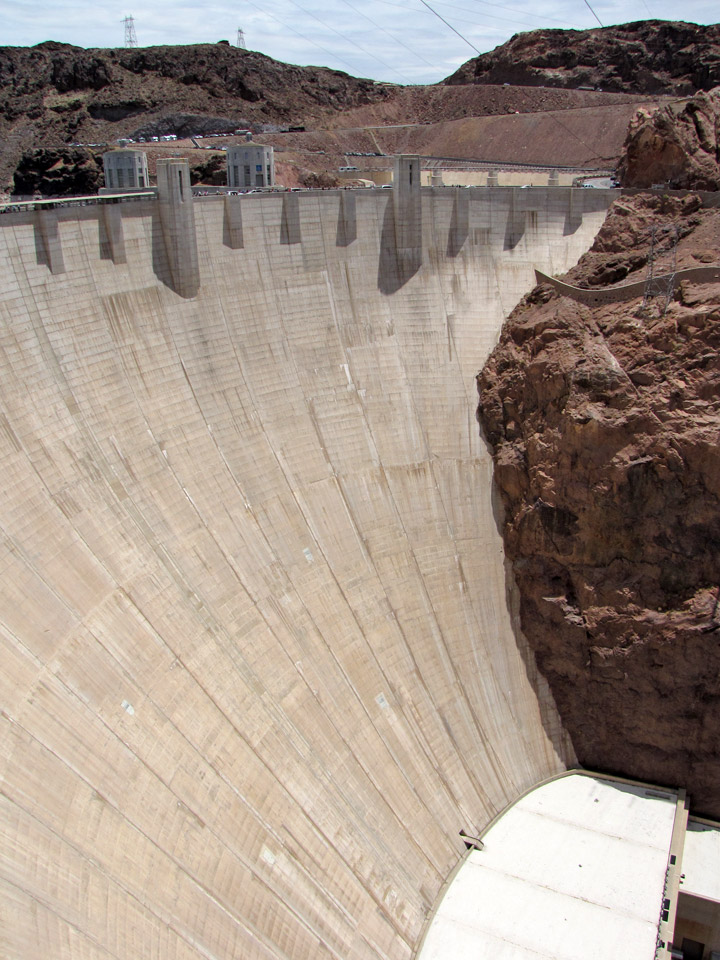
Control of water was the primary concern in the building of the dam. Power
generation allowed the dam project to be self sustaining: repaying the 50-year
construction loan, and continuing to pay for the multi-million dollar yearly
maintenance budget. Power is generated in step with and only with the release of
water in response to downstream water demands.
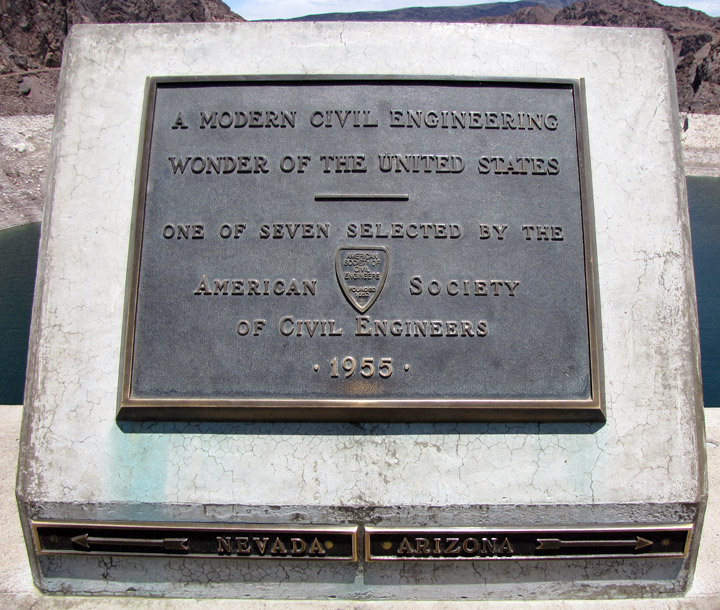
The dam crosses the border between two time zones, the Pacific Time Zone and the
Mountain Time Zone
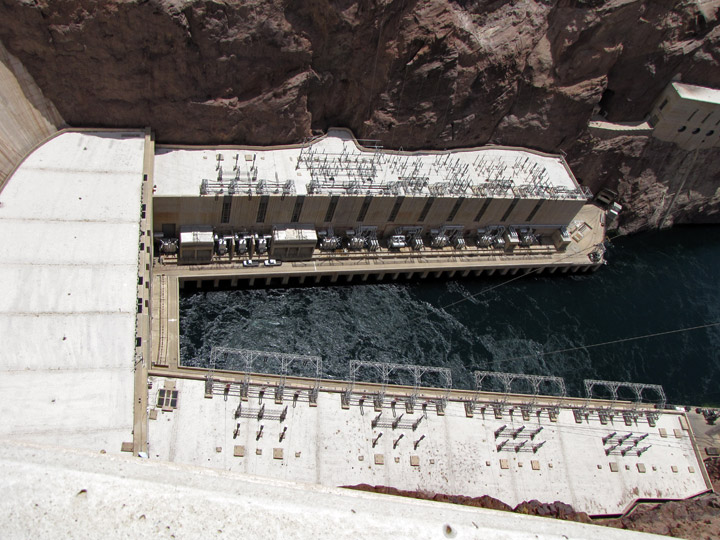
The initial plans for the finished facade of both the dam and the power plant
consisted of a simple, unadorned wall of concrete topped with a Gothic-inspired
balustrade and a powerhouse that looked like little more than an industrial
warehouse. This initial design was criticized by many as being
too plain and unremarkable for a project of such immense scale, so Los
Angeles-based architect Gordon B. Kaufmann was brought in to redesign the exteriors. Kaufmann greatly streamlined the buildings, and
applied an elegant Art Deco style to the entire project, with sculptured turrets
rising seamlessly from the dam face and clock faces on the intake towers set for
Nevada and Arizona time, in the Pacific and Mountain time zones respectively
(although because Arizona does not observe daylight saving time, the two clocks
show the same time during the warmer half of the year).
Text from Wikipedia
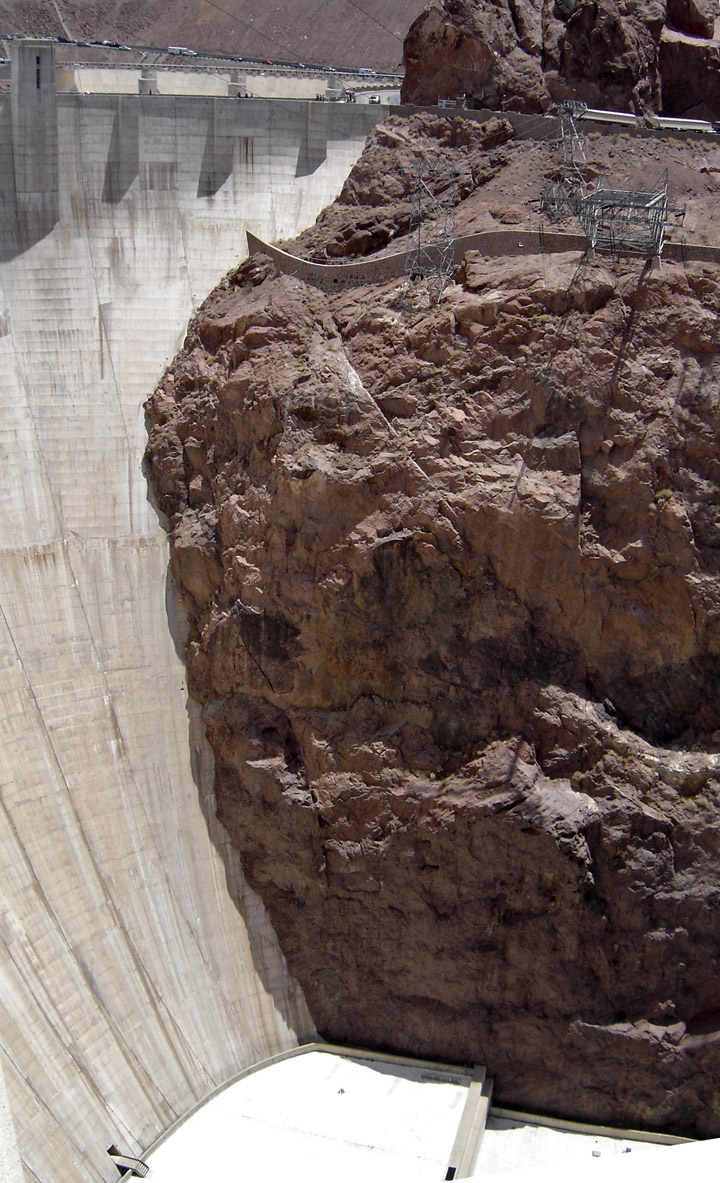
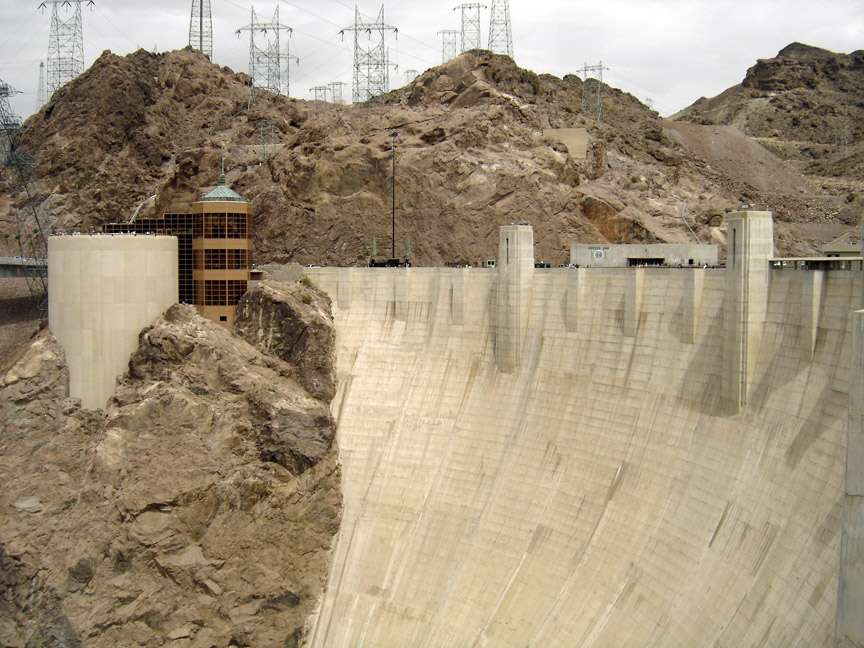
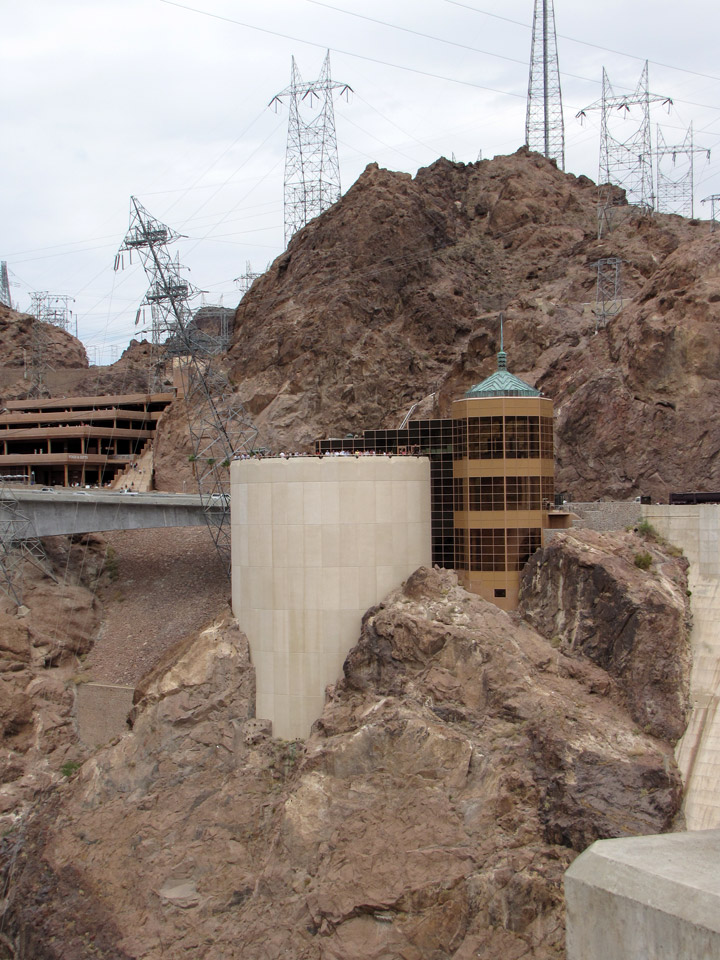
viewing platform and visitors center
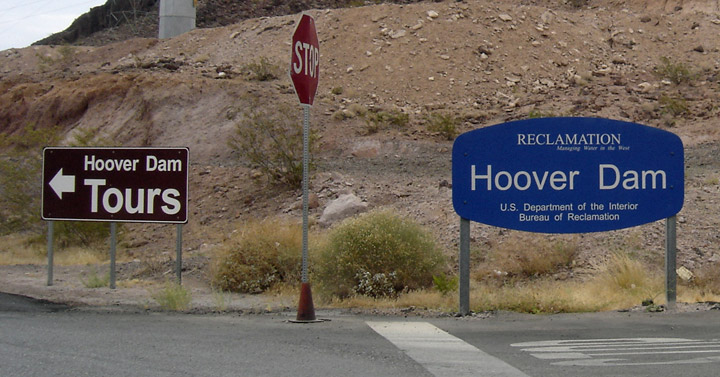
be sure to take the tour
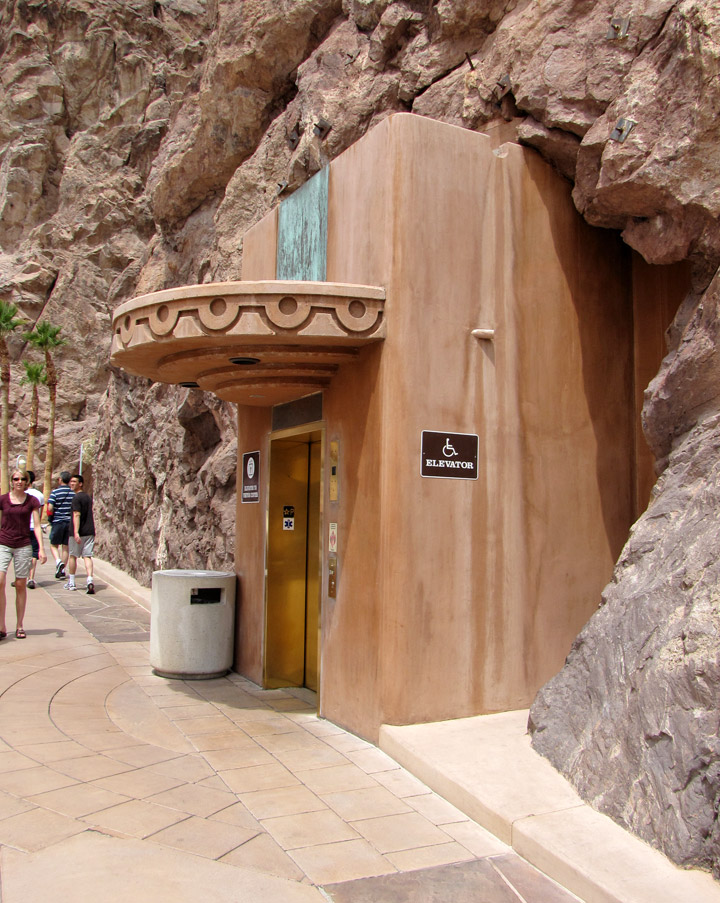
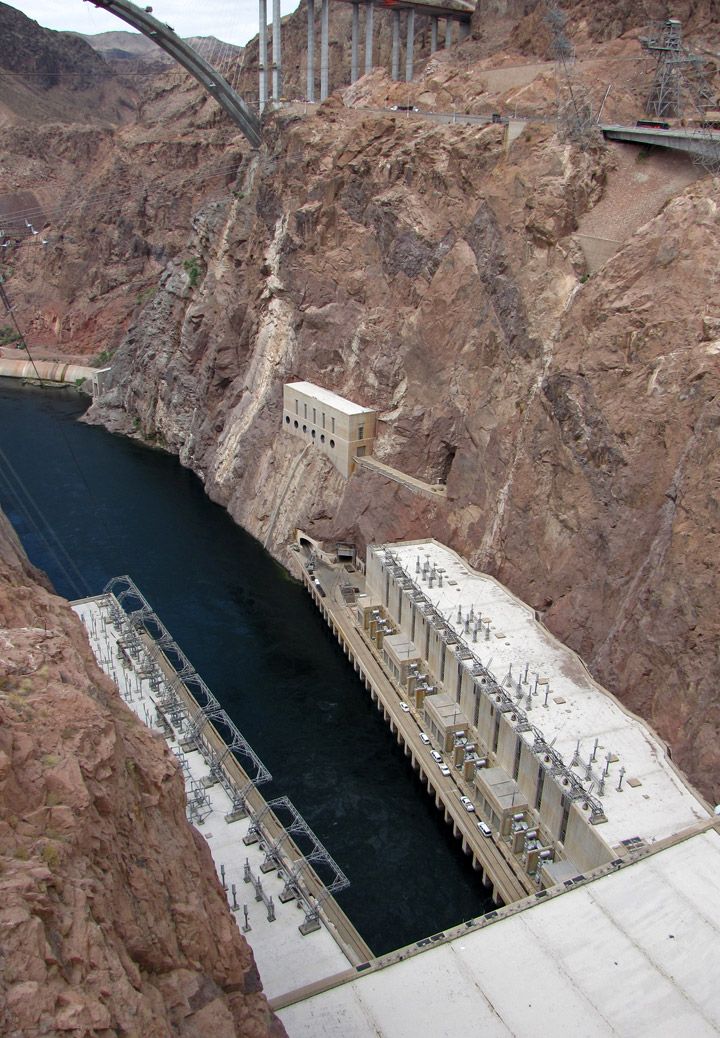
the power plant
More Photos from the Arizona side